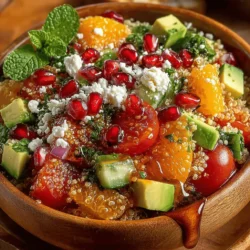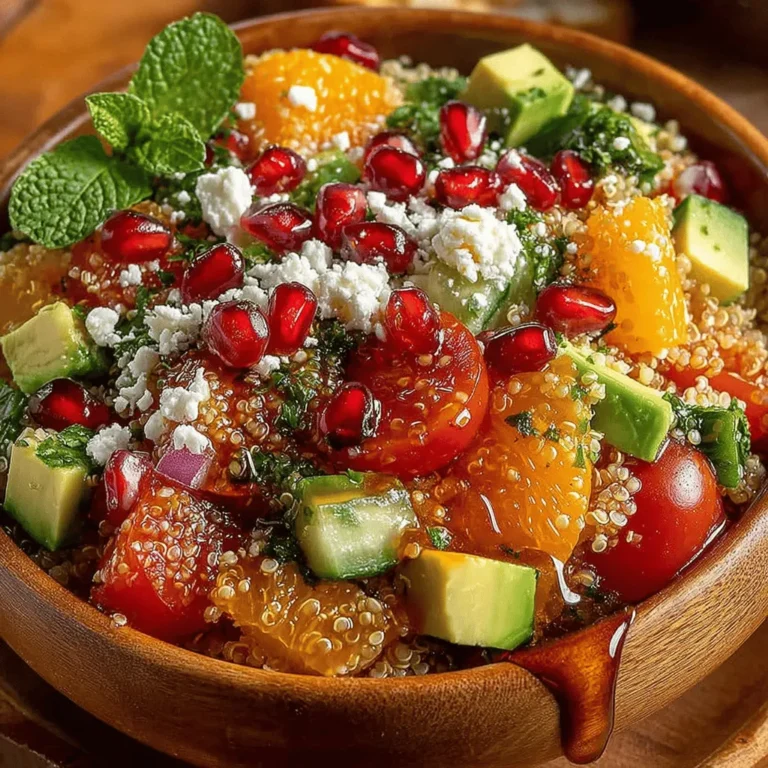Introduction to Quinoa Tabbouleh with a Twist
In recent years, quinoa has taken the culinary world by storm, celebrated for its versatility, nutritional benefits, and ability to absorb flavors. This ancient grain, often mistaken for a cereal, is actually a seed from the flowering plant Chenopodium quinoa, native to the Andean region of South America. In this article, we explore an exciting and refreshing take on a classic Middle Eastern dish—Quinoa Tabbouleh with a Twist. This vibrant salad combines wholesome ingredients, distinctive flavors, and an added layer of nutrition, making it perfect as a light meal or a side dish for any occasion. Whether you’re a seasoned cook or a kitchen novice, this quinoa tabbouleh recipe is approachable and sure to please.
Understanding the Essence of Tabbouleh
To fully appreciate the innovative approach to this dish, it’s essential to understand the origins and traditional elements of tabbouleh. Historically, tabbouleh is a Levantine salad that originated in the region that includes modern-day Lebanon and Syria. The classic recipe features finely chopped parsley, tomatoes, mint, and bulgur wheat, dressed with olive oil and fresh lemon juice. Over the decades, tabbouleh has become a staple in Mediterranean cuisine, often served as part of a mezze platter alongside hummus and pita bread.
The cultural significance of tabbouleh extends beyond its delightful flavors; it represents a celebration of fresh ingredients and communal dining. Traditionally enjoyed during gatherings and family meals, tabbouleh showcases the importance of herbs and vegetables in Middle Eastern culinary practices and reflects a lifestyle that values healthful, plant-based eating.
The Nutritional Benefits of Tabbouleh
Tabbouleh is not only a delicious dish but also a nutritional powerhouse. The key ingredients contribute numerous health benefits, making it a favorable choice for those looking to enhance their diet.
1. Parsley: Rich in vitamins K and C, parsley aids in digestion and is known for its anti-inflammatory properties.
2. Tomatoes: A great source of antioxidants, particularly lycopene, tomatoes support heart health and provide hydration.
3. Mint: Beyond its refreshing flavor, mint can aid digestion and has been linked to improved mental clarity.
While bulgur wheat is the traditional grain used in tabbouleh, quinoa presents an excellent alternative, especially for those seeking gluten-free options or additional protein. Quinoa is a complete protein, containing all nine essential amino acids, making it an ideal choice for vegetarians and health-conscious individuals. Additionally, quinoa is rich in fiber, magnesium, and various vitamins, which contribute to overall well-being.
Ingredients Breakdown
To create your own Quinoa Tabbouleh with a Twist, it’s crucial to understand the role of each ingredient in the recipe.
Quinoa: The Star of the Dish
As the centerpiece of this dish, quinoa brings a nutty flavor and a slightly chewy texture that complements the fresh ingredients beautifully. When selecting quinoa, look for high-quality, organic varieties for the best flavor and nutritional value.
How to Select and Prepare Quinoa Properly: Rinse the quinoa under cold water to remove its natural coating, called saponin, which can impart a bitter taste. After rinsing, cook it in a 2:1 ratio of water to quinoa, bringing it to a boil before lowering the heat and simmering until the grains are fluffy and translucent. Allow it to cool before mixing it with other salad ingredients.
Fresh Herbs: Parsley and Mint
No tabbouleh is complete without the vibrant freshness of parsley and mint. These herbs are essential not only for flavor but also for the dish’s aromatic appeal.
Tips for Selecting Fresh Herbs: When choosing herbs, look for bright, vibrant leaves free of wilting or browning. Fresh parsley should have a fragrant smell, and mint should be aromatic with a crisp texture. Chopping these herbs finely releases their essential oils, contributing to the overall flavor profile of the salad.
Colorful Vegetables that Add Crunch
In addition to the herbs, colorful vegetables are key components that add both texture and nutrition to the dish.
– Cucumbers: Their crispness complements the soft quinoa, providing a refreshing crunch. Cucumbers are low in calories but high in water content, making them a hydrating addition.
– Cherry Tomatoes: Sweet and juicy, cherry tomatoes enhance the dish with their natural sweetness and vibrant color.
– Red Onion: Offering a mild sharpness, red onions balance the sweetness of the tomatoes and the freshness of the herbs.
Adding these vegetables not only boosts the flavor but also increases the dish’s nutritional profile, providing an array of vitamins and minerals.
Dressing: The Flavor Enhancer
The dressing is what brings all the ingredients together, creating a harmonious blend of flavors. A classic tabbouleh dressing consists of high-quality olive oil, fresh lemon juice, salt, pepper, and a hint of cumin.
Analyzing the Components of the Dressing: Olive oil serves as a source of healthy fats, essential for nutrient absorption. Lemon juice adds acidity, brightening the dish and enhancing the flavors of the fresh ingredients. The balance between acidity and fat is critical; it elevates the overall taste experience.
Optional Ingredients for a Unique Twist
To elevate this quinoa tabbouleh, consider incorporating optional ingredients that add both flavor and visual appeal.
– Avocado: Adding diced avocado brings creaminess to the salad, enhancing its texture and providing healthy fats.
– Pomegranate Seeds: These jewel-like seeds add a burst of sweetness and a pop of color, making the dish visually stunning while offering antioxidants.
Incorporating these optional ingredients not only enhances the dish’s visual appeal but also introduces unique flavors that differentiate this quinoa tabbouleh from traditional recipes.
As you prepare your Quinoa Tabbouleh with a Twist, the combination of fresh herbs, vibrant vegetables, and a flavorful dressing creates a dish that is not only nutritious but also a feast for the senses. Stay tuned for the next part of this article, where we will delve into the complete preparation process, sharing tips and tricks to ensure your salad is a resounding success.
Step-by-Step Preparation Guide
Cooking the Quinoa
To achieve perfectly cooked quinoa, start by rinsing one cup of quinoa under cold water. This step is crucial as it removes the natural coating called saponin, which can impart a bitter flavor. After rinsing, combine the quinoa with two cups of water in a medium saucepan. Bring it to a boil over medium-high heat. Once boiling, reduce the heat to low, cover the saucepan, and let it simmer for about 15 minutes or until all the water is absorbed.
After cooking, remove the saucepan from heat and let it sit covered for an additional 5 minutes. This resting period allows the quinoa to steam and become fluffy. Fluff the quinoa gently with a fork to separate the grains. For cooling the quinoa efficiently, spread it on a baking sheet in a thin layer. This method promotes even cooling and prevents the grains from clumping together.
Chopping and Preparing the Vegetables
The success of your quinoa tabbouleh hinges on how you prepare your vegetables and herbs. Start by finely chopping one cup of fresh parsley, half a cup of mint, and half a cup of cherry tomatoes. The key to uniformity in chopping is to use a sharp knife and a stable cutting board. For herbs, stack the leaves, roll them tightly, and slice them into thin ribbons (a technique known as chiffonade).
For the cucumber, cut it in half lengthwise, remove the seeds with a spoon, and then dice it into small cubes. The importance of ingredient preparation cannot be overstated; uniform chopping helps to ensure that every bite delivers a balanced combination of flavors and textures.
Making the Dressing
Creating the dressing for your quinoa tabbouleh is where you can truly add your personal touch. In a small bowl, whisk together the juice of one lemon, three tablespoons of olive oil, one minced garlic clove, and salt and pepper to taste. To achieve the right emulsification, start by whisking the lemon juice and garlic together, then slowly drizzle in the olive oil while continuing to whisk. This technique helps combine the oil and vinegar (in this case, lemon juice) smoothly.
Taste the dressing as you go and adjust the seasonings according to your preference. If you prefer a tangier dressing, add more lemon juice. For a richer flavor, a touch more olive oil can enhance the overall taste.
Combining the Ingredients
Once all your ingredients are prepped and the quinoa is cooled, it’s time to bring everything together. In a large mixing bowl, combine the cooled quinoa with the chopped vegetables and herbs. Use a gentle folding motion to mix the ingredients, being careful not to mush the quinoa. The goal is to have the quinoa well-coated with the vegetables and dressing while maintaining the integrity of the grains.
As you mix, look for visual cues indicating that the salad is well-coated. The quinoa should take on the color of the dressing, and the herbs and vegetables should be evenly distributed throughout.
Garnishing for Presentation
Presentation can elevate your quinoa tabbouleh from delicious to truly enticing. Consider garnishing with additional mint leaves or a sprinkle of crumbled feta cheese for a Mediterranean flair. You can also serve the salad in hollowed-out bell peppers or on a bed of mixed greens for a vibrant display. The impact of garnishing on overall dish appeal is significant; it not only makes the dish more visually appealing but can also enhance the flavor profile, inviting your guests to dig in.
Serving Suggestions and Pairings
Ideal Occasions to Serve Quinoa Tabbouleh
Quinoa Tabbouleh with a Twist is wonderfully versatile, making it an ideal dish for various occasions. It’s perfect for summer barbecues, picnics, or potluck gatherings, where its fresh flavors can shine. Serve it as a light lunch option or as a side at dinner parties. This salad can also be a great addition to meal prep, as it stores well in the refrigerator for a couple of days, allowing you to enjoy its flavors throughout the week.
When incorporating quinoa tabbouleh into larger meal plans, consider pairing it with grilled chicken or fish for a balanced meal. The lightness of the salad complements heartier proteins without overwhelming the palate.
Complementary Dishes
To enhance your Mediterranean-themed meal, pair quinoa tabbouleh with dishes like grilled lamb skewers or a flavorful shawarma. The spices in these main courses harmonize beautifully with the fresh herbs in the salad.
For side dishes, consider serving roasted eggplant, hummus, or a classic tzatziki sauce. These items not only complement the flavors of the tabbouleh but also add a variety of textures and tastes to your meal, creating a well-rounded dining experience.
Conclusion: Embrace the Twist in Your Tabbouleh
Quinoa Tabbouleh with a Twist is more than just a salad; it’s a celebration of flavors, colors, and nutrition. Through this recipe, you can explore the delightful fusion of traditional and contemporary culinary practices. This dish invites you to nourish your body while enjoying the vibrant tastes of fresh ingredients.
Whether enjoyed on its own or as part of a larger spread, this quinoa tabbouleh is sure to become a staple in your kitchen repertoire. Embrace this healthy twist on a classic, and let your taste buds rejoice!



